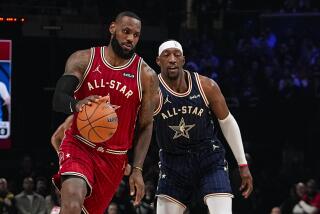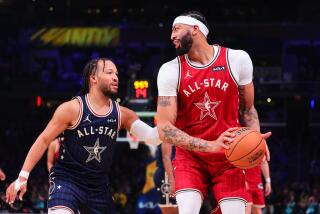Too big for Vegas? That’s too big
Now the league that patented controversy brings you the All-Star weekend that won’t die.
Remember “What happens in Vegas stays in Vegas?” That was up until the NBA hit town.
In the latest of our series of retrospectives, we find the aftermath has eclipsed the event, which is in the process of being downgraded from fabulous to notorious.
In fact, neither the NBA nor its players did anything wrong. The only athlete involved in a violent incident was from the NFL, Tennessee’s Adam “Pacman” Jones.
And yes, the NBA has a problem: The crowds.
In recent years, All-Star weekend has been swamped by fans pouring in by tens of thousands to go to the parties -- or party with each other or watch celebrities (some of whom actually show) climb out of their limos.
Even in big convention centers, the only places it’s held any more, their sheer numbers overwhelm all systems: police, traffic, hotels, restaurants, airports.
Even Las Vegas’ 24/7 tourist industry couldn’t handle what Mayor Oscar Goodman called “a heavyweight fight, New Year’s Eve, Super Bowl Sunday and the Final Four all wrapped up together.”
At the heart of the controversy, if rarely directly noted, is the fact that the crowds were predominantly African American, with all that portended for local perceptions.
The All-Star weekend was two weeks ago, and on that Friday, before stories about trouble began surfacing, I heard stories about local merchants calling for security as huge crowds roamed the casinos’ mini-Rodeo Drive malls.
With the infrastructure submerged -- endless cab lines, all-night gridlock on the Strip, half-mile airport check-in lines -- there weren’t enough police, guards and bouncers to handle the estimated 85,000 visitors, either.
A weekend of lesser incidents led to an early-morning Monday shooting, the day after the All-Star game, at Minxx Gentlemen’s Club in a melee that police said started after Jones and his entourage showered $81,000 over strippers.
(No charges were filed against Jones. His attorney said he left before the shooting, which wounded two club employees and a female patron, and was only interviewed by police as a witness.)
Imagine the NBA players’ delight when they heard about the trouble -- and found out it was coming back to them.
You could have been there all weekend, as most of them were, without knowing how bad it was on the street.
The Vegas experience is defined by class. If you could afford to stay at the mammoth MGM Grand, you could take crosswalks or trams to New York New York, Excalibur, Luxor and Mandalay Bay (all owned by MGM Grand Mirage) without setting foot on the sidewalk.
Breaking out of one’s complex was an adventure. Players with limos at their disposal sat in traffic like everyone else.
“I didn’t leave my hotel until I was headed to an event,” the Rockets’ Rafer Alston told the Houston Chronicle. “I didn’t even leave to go to eat. I ate in my hotel. It was the overall atmosphere. The whole feeling didn’t feel safe.”
Complaints about unruly visitors are nothing new in Las Vegas, where the police put arrest reports into perspective by subtracting off the average number of incidents for an ordinary weekend and noting how many have local addresses.
No Las Vegas convention, like this one that generated an estimated $90 million in non-game revenue, winds up looking too bad, at least under normal circumstances that didn’t apply to this mother of all parties.
The backlash from NBA players heated up so fast, union director Billy Hunter popped his cork, threatening to sue to keep next year’s event out of municipally strained New Orleans, worrying the crowds would “shut the city down.”
The league was obliged to re-state that it’s coming and the players to state they have nothing against New Orleans.
In the bad news, this isn’t just about New Orleans. If All-Star weekend can overrun Las Vegas, no city is safe.
Taking it to Vegas multiplied an already mushrooming effect, attracting even bigger crowds and underscoring the dangers they could pose.
Once a three-hour showcase, the All-Star game became a weekend in the ‘80s, starting with a Saturday dunk show it picked up from the ABA in a marketing coup that was copied by other leagues.
In recent years with networks and sponsors paying billions, it morphed into an all-important corporate schmooze, even if that meant displacing thousands of season-ticket-holding fans and complaints from host teams.
The party craze started becoming a folk movement in 2001 in Washington, the first of three in the East (2002 in Philadelphia, 2003 in Atlanta).
In Atlanta, the convention center of the South, downtown traffic was impassible, even on the weekend, and several packed malls were closed.
By the 2004 game in Staples Center, the league was obliged to put the event on itself, after the Lakers declined an invitation to play hosts.
Congestion aside, the crowds triggered little concern, with the exception of an overheated newspaper story about gearing up for rapper wars in Denver in 2005.
The crowds suggested the NBA’s popularity, which was the point. Hotbeds without enough hotel rooms, such as Portland and Sacramento, couldn’t even apply.
This event doesn’t belong to a city but to the NBA, which has to downsize it to manageable proportions. Before anyone starts generalizing about 85,000 people, their race wasn’t the problem. Their numbers were.
*
More to Read
Go beyond the scoreboard
Get the latest on L.A.'s teams in the daily Sports Report newsletter.
You may occasionally receive promotional content from the Los Angeles Times.










